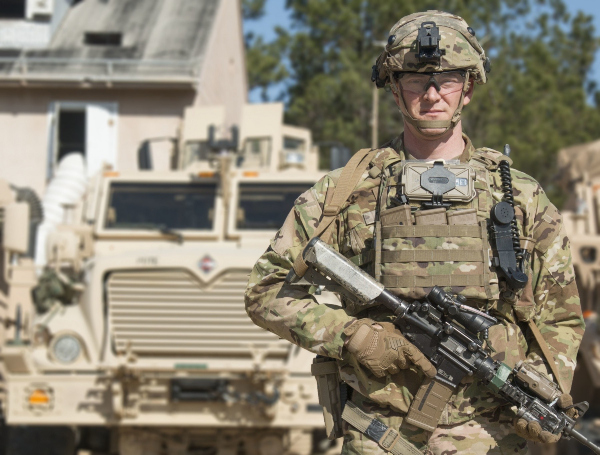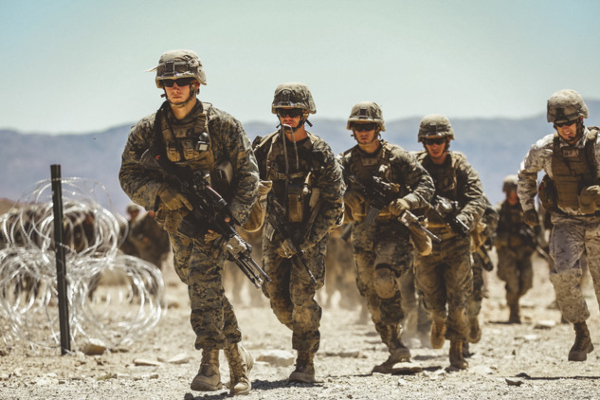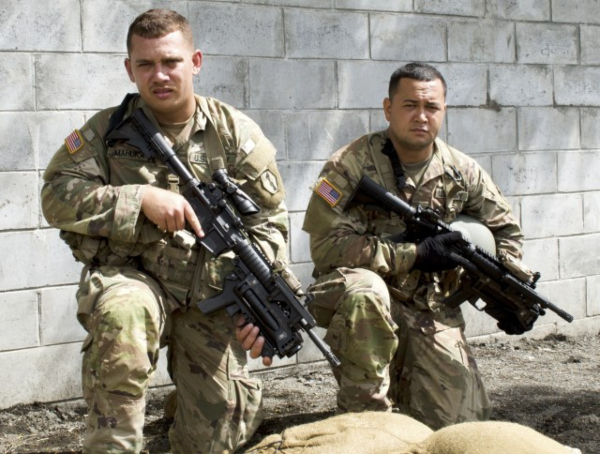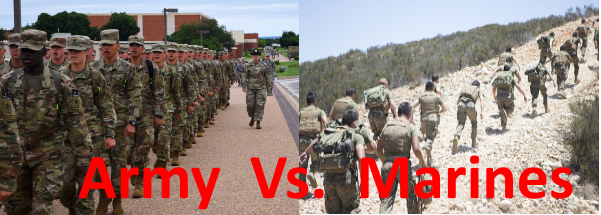The United States Army and Marine Corps are two of the most popular branches of the Armed Forces to enlist in.
Both military branches have a few similarities, yet are also different in many regards.
Regarding the Army vs. Marines, is one particular military branch superior to the other in terms of responsibilities, command, and benefits?
Keep reading to learn more about the differences between the U.S. Army and Marine Corps.
Related Article: Which Branch Of The Military Should I Join? 7 Things To Consider
Table of Contents
What is the U.S. Army?

The United States Army (USA) serves as the land warfare branch of the military.
It’s also the oldest of the American military branches with origins in the Revolutionary War.
The U.S. Army was officially recognized as a military force in 1784 after the country received its independence.
The motto of the Army is “This We’ll Defend.”
Here are some more details about its size, responsibilities, and command:
How big is the US Army?
The US Army is by far the largest military branch in the United States.
It has an even larger margin compared to the second biggest (U.S. Navy) when you add the United States National Guard and Reserves.
There are currently over 482,000 active-duty personnel in the U.S. Army.
The Army National Guard contributes another 337,000 members and the Army Reserve adds over 180,000.
In total, there are over 1 Million members serving the United States Army in some capacity.
As a result, the U.S. Army is substantially bigger than the Marine Corps.
What does the Army do?
The U.S. Army provides the main ground force in the country.
Therefore, it has the primary objective of protecting and defending the country.
Its major ways to attack or defend are with ground troops, armor (i.e. tanks), artillery, and helicopters.
The United States calls upon US Army personnel to preserve the peace and security of the nation.
Its mission is “to fight and win our Nation’s wars, by providing prompt, sustained land dominance, across the full range of military operations and the spectrum of conflict.”
The most legendary military branch in terms of history has been involved in every major conflict since the Revolutionary War.
What are their responsibilities?
The Army acts as the land branch of the U.S. Armed Forces.
In other words, it protects the country domestically as well as internationally on land.
The overall responsibilities of the Army include:
- Supporting national policies
- Implementing national objectives
- Overcoming any nations responsible for aggressive acts that imperil the peace and security of the country
- Preserving the peace and security of the nation by providing defense of the United States, the Commonwealths and possessions, as well as the other areas occupied by the U.S.
NOTE: The Army released a new strategy in 2018 which adds some points of emphasis for modernized conflict that plan to get implemented over the next decade.
What is their command structure?
The U.S. Army acts within the Department of the Army.
The Department of the Army is one of the three military departments under the Department of Defense.
As a result, the U.S. Army is led by the following appointees:
- Secretary of the Army (SECARMY) (Civilian Senior Appointed Servant)
- Chief of Staff of the Army (Chief Military Officer)
The Army is separated into:
1) Regular Army
2) Army Reserve
3) National Guard
From there, the Army divides its units into several branches and functional areas.
The branches include officers, warrant officers, and enlisted soldiers.
Meanwhile, functional areas only consist of officers that were reclassified from their former branch.
The U.S. Army incorporates two Reserve units.
Both the regular Army and Army Reserve receive structure under Title 10 of the United States Code.
On the other hand, the Army National Guard is organized under Title 32.
Though it is trained and equipped to support the U.S. Army when it’s not in federal service, the National Guard operates under the command of state governments.
Related Article: 13 Pros And Cons Of Joining The Marines
What is the Marine Corps?

The United States Marine Corps (USMC) has the responsibility of conducting expeditionary and amphibious operations.
While it primarily operates with the United States Navy, the Marine Corps may also support operations with the Army and Air Force.
The military branch has acted under a component of the U.S. Navy since 1834.
The motto of the Marine Corps is “Semper Fi” (or “always faithful”).
Here are some more details about its size, responsibilities, and command:
How big is the Marine Corps?
The Marine Corps is the smallest of the four primary military branches (Air Force, Navy, Army, and USMC).
However, it has more personnel compared to the United States Coast Guard.
Regardless, the Marine Corps is less than twice the size of the U.S. Army for comparison.
All in all, the USMC has 177,200 active-duty personnel along with another 32,400 Marine Reserve.
What does the Marine Corps do?
The United States Marine Corps has multiple objectives.
The military force generally carries out operations abroad and gets trained in land and water operations.
USMC operates installations on land and with sea-going amphibious warfare ships.
Marines act as a defense of advanced naval bases and other land operations that support naval campaigns but may extend to other Armed Forces branches.
The selective branch has elite Marines prepared and ready for combat on a variety of terrains and situations.
A focus on infantry in the USMC enforces the doctrine of “every Marine is a rifleman”, regardless of Military Occupational Specialty (MOS).
Marines have been involved in every major U.S. conflict and continue to serve a tremendously important role in protecting the country.
What are their responsibilities?
U.S. Marines provide a critical role as the amphibious warfare force of the Armed Forces.
The Marine Corps is able to support asymmetric warfare with conventional, irregular, or hybrid forces.
Marines are capable of deploying nearly anywhere in the world within days through combined-arms task forces (MAGTF).
The three primary areas of responsibility for the Marine Corps include:
- Seizure or defense of advanced naval bases and other land operations to support naval campaigns.
- Development of tactics, techniques, and equipment used by amphibious landing forces in coordination with the Army and Air Force.
- Other duties the United States President or Department of Defense issues to the military branch.
Additionally, the Marine Corps implements its own special forces known as MARSOC.
What is their command structure?
The U.S. Marine Corps (USMC) operates under the Department of the Navy.
The Department of the Navy is led by the Secretary of the Navy who answers to the Department of Defense.
A Commandant serves as the highest-ranking Marine officer in the military branch.
The Commandant handles organization, recruiting, and training for the Marine Corps and delegates additional orders to Combatant Commanders.
From there, the Marine Corps branches into four subdivisions:
- Headquarters Marine Corps (HQMC)
- Operating Forces
- Supporting Establishment
- Marine Forces Reserve (USMCR)
Each USMC subdivision has several leaders and its own unique structure.
The Operating Forces subdivision divides into three categories:
- Marine Corps Forces (MARFOR)
- Fleet Marine Forces (FMF)
- Security Forces
Marine Corps Forces are separated into Forces Command (MARFORCOM) and Pacific Command (MARFORPAC).
The Marine Corps also has a structure for the Marine Air-Ground Task Force (MAGTF).
MAGTF uses a common Command Element (CE) to oversee:
- Ground Combat Element (GCE)
- Aviation Combat Element (ACE)
- Logistics Combat Element (LCE)
In general, the command structure of the USMC is to promote self-sufficiency and a commitment to combined arms.
Army vs. Marines: 5 Key Differences

The U.S. Army and Marine Corps have several similarities.
Both uniformed branches are instrumental in keeping our nation safe.
Placing emphasis or claiming that one branch is better than the other is frivolous.
Here are 5 key differences between the USMC and Army:
Difference #1: Responsibilities
The Army is responsible for land-based military operations.
Meanwhile, the Marine Corps handles “amphibious” operations, which means they can carry out operations on land and water.
Both military branches have a goal to preserve the peace and security of the nation.
The Army acts more as a defense for the United States by supporting national policies, implementing objectives, and overcoming nations that perpetrate aggressive acts towards the U.S.
On the other hand, Marines assault, capture, and control beachheads to provide a direct route to enemy forces.
Though the Marine Corps acts as an amphibious unit, most Marines have a warfare specialty.
For example, some Marines specialize as a Rifleman (MOS 0311) while others focus on Antitank Missileman (MOS 0352).
On the opposite spectrum, soldiers in the Army may only enlist as standard Infantrymen (MOS 11B) or Indirect Fire Infantrymen (MOS 11C).
The Army has special forces like Green Berets and Rangers, while the Marine Corps has MARSOC and Recon.
Related Article – Green Berets vs. Navy SEALs: 4 Major Differences
#2: Command
The U.S. Army is technically older, however, the Marine Corps also has origins from the American Revolutionary War.
The USMC operates under the United States Navy to deliver combined-arms task forces.
Both rifle platoons share many elements.
Marine and Army platoons get organized into larger companies with subordinate squads.
The two military branches also rely on company and battalion commanders for orders.
However, the differences in command and organization between the two branches are seen in the sizes of the squads.
Typically, Army platoons have smaller squads with a leader in charge of two 4-man fire teams.
An Army fire team in infantry consists of a team leader, automatic rifleman, grenadier, and regular rifleman.
Army squads assign one team member to act as the designated marksman.
The Army provides an additional squad in each platoon which serves as the infantry weapons squad – a feature not used in the USMC.
On the contrary, the Marine Corps rifle platoon consists of three rifle squads.
Each squad features a sergeant who serves as the leader and supervises three fire teams.
Each fire team has a corporal that the squad leader may delegate responsibilities in the chain of command.
The fire team leader supervises an automatic rifleman, assistant automatic rifleman, and regular rifleman.
#3: Eligibility
The Army allows new members to enlist between the ages of 17 and 35.
However, you need parental consent to join the Army if you are under the age of 18.
The U.S. Army also requires you to be a citizen of the United States or a legal permanent resident.
Meanwhile, the Marine Corps allows you to consider joining as early as 17 (with the same parental consent), but the maximum age to enlist is 28.
The Marine Corps and Army are the same (like every military branch) in that new recruits must complete the Armed Services Vocational Aptitude Battery (ASVAB).
The series of tests inform the Armed Forces of your strengths and weaknesses regarding a Military Occupational Specialty (MOS), or military job.
Recruits in both military branches must also pass a medical and dental exam.
There are additional requirements such as physical fitness standards (Army and Marine Corps) you must reach to prove your worth in the Armed Forces.
New recruits endure different basic training (boot camp) depending on the military branch.
Army Basic Combat Training (BCT) lasts 10 weeks.
Meanwhile, the Marine Corps Basic Training lasts 13 weeks.
After completing boot camp, new recruits in the Army progress to Advanced Individual Training (Army AIT) while Marines transition to School Of Infantry (SOI).
All in all, Marine boot camp is considered by most more physically and mentally demanding compared to Army boot camp.
Related Article – 3 Steps for Visiting an Army Recruiter Near You
#4: Weapons
The United States Army is usually the first to get new weapons.
For example, Army personnel began receiving the M4 before the Marine Corps made the same transition.
The Army also tends to introduce new add-ons like optical sights, hand grips, and lasers before other military branches.
However, it’s not to suggest that Marines don’t also have access to some really sophisticated weapons and technology.
The Army relies on weapons like AT-4s, SMAWs, and Javelins.
On the other hand, the USMC likes to rely on the SMAW.
The Army prefers the M320 as its primary grenade launcher while the Marine Corps turns to the M32A1.
Regardless, both grenade launchers may get mounted on either an M4 or M16 rifle.
Both military branches have fire support on the battlefield.
Army and Marine units rely on mortar, heavy machine guns, and missile/rocket support from their battalion when fire support isn’t available from the company.
However, artillery and close air support methods are different between the Marine Corps and the Army.
For example, the Marine Expeditionary Unit utilizes artillery, air, and naval assets for fire support.
Meanwhile, the Marines on a brigade combat team only receive artillery support outside the BCT, while the Army receives air support from the Army combat aviation brigade.
The Army typically turns to naval fire support last with a reliance more on the Air Force.
#5: Promotions
The U.S. Army and USMC have differences when it comes to opportunities for career advancement.
The Military Occupational Specialties for the Army and Marine Corps are different.
For example, the USMC does not provide its own doctors or dentists since it turns to the Navy for those needs.
Therefore, you’ll find more options for serving in the U.S. Army, including more non-combat Military Occupational Specialties (MOS).
Each MOS in the Marine Corps and Army features a specific list of requirements.
You need to complete specific training activities to qualify for a MOS after passing the minimum requirements on the ASVAB.
Additionally, many Army and Marine MOS require a security clearance.
Military security clearance gets managed by the Department of Defense.
The Department of Defense currently has three levels of security clearance: confidential, secret, and top secret.
Secondly, members that serve in the U.S. Army and Marine Corps also have the distinct opportunity to join special forces.
Marines that excel in standard infantry units have the opportunity to compete for a prized spot on Force RECON.
Marine Force RECON includes promotions like scout snipers or reconnaissance.
On the other hand, Army personnel may advance to the airborne unit by completing a three-week course in parachuting.
The Army Ranger program is a harder military promotion to attain and requires you to complete Ranger School or get picked from the Ranger Assessment and Selection Program.
Army infantry has the opportunity to join Special Forces or become a sniper after graduating from its sniper school.
Conclusion
Army vs. Marines…which one will you choose?
Both military branches offer their advantages and disadvantages.
Ultimately, you need to select one military branch to enlist in, so considering the 5 major differences can help make your decision easier.
References
https://www.globalsecurity.org/military/agency/end-strength.htm
https://www.army.mil/organization/
- Replacing Dog Tags: 6 Things You Need to Know - June 28, 2024
- Navy OAR Test Study Guide - June 24, 2024
- 10 Best Sniper Movies of all Time - June 20, 2024
Originally posted on March 22, 2020 @ 2:13 pm
Affiliate Disclosure: This post may contain affiliate links. If you click and purchase, I may receive a small commission at no extra cost to you. I only recommend products I have personally vetted. Learn more.


Excellent article!
While I served in both USMC (Nam) & later ARNG, I found your explanations an encouragement to those who may become our nations defenders.
Thank You,
AL Easton